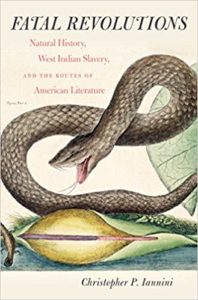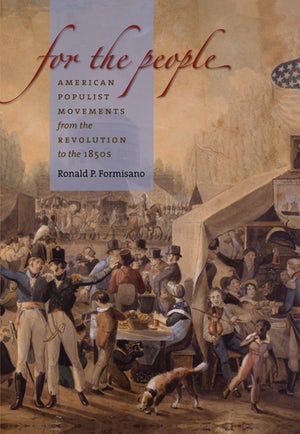In Fatal Revolutions, Iannini connects the growth of the West Indian plantation as a new social and economic institution to the rise of natural history as a scientific and literary discourse and argues that these developments establish the conditions for the practice of letters in the eighteenth-century Americas (3). The first part of this study examines the primacy of the West Indies in the emergent literary and scientific practices of natural history in the Atlantic world. Early natural histories by Hans Sloane and Mark Catesby not only circulate knowledge about the colonies but also raise complex questions about the “moral significance of colonial slavery,” about the geographical bounds of the Caribbean region, and about the possibility of improving its climate through plantation-style agriculture (9). In part two, Iannini demonstrates that this Caribbean-centered natural history lays the groundwork for the articulation of new political and social identities in late colonial North America and the early United States. Crèvecoeur, William Bartram, Jefferson, and Audubon appropriate the “ideological assumptions, discursive conventions, and representational techniques” of earlier Caribbean natural histories to debate the implications of plantation slavery for a nation ostensibly committed to equality. Iannini concludes that these later writers remove the Caribbean from its privileged place within natural history and replace it with North America to argue that the continent’s natural abundance will fuel a “planetary future of republican liberty” (16).
In the first chapter, Iannini draws on the work of art historian Kay Dian Kriz to argue that Sloane’s formally sophisticated and lavishly printed Voyage to … Jamaica (1707-1725) revived early modern techniques of representation to present the ‘”specimen-as-emblem”‘ (26). Sloane connected the objects he examined to larger spiritual or social contexts using a combination of visual cues and supporting text. Readers interpreted Sloane’s engravings and drawings by consulting the image’s label, the index, and descriptive sections, with the goal of locating the objects’ “hidden providential or socioethical significance” (7). Thus, as people read Voyage to … Jamaica, they not only analyzed objects from the Caribbean but also considered the contexts of plantation slavery and agricultural transformation in which these objects originated, and they contemplated their own roles as consumers in global commercial networks. Natural histories did not, as the now standard account holds, efface the contexts in which collectors and readers encountered objects. Instead, the specimen-as-emblem represented the new relationships that global commerce created among objects, merchants, and consumers and between planters and enslaved Africans.
Iannini shows that Sloane employed emblems to address the challenges posed by new West Indian commercial objects, from Africans who were valued as chattel slaves to specimens of natural knowledge such as sugar cane that were also important commodities. Formal experimentation—mixing narrative with description—and complex emblematic representations—combining human and natural objects—allowed Sloane to evoke the histories in which objects obtained their meaning and value. Iannini examines, for example, the engraving of “Land Crab and Pot Shards Found in a Cave,” which juxtaposes natural and human artifacts. By consulting the printed labels, index, and catalog descriptions for each object, a reader would discover that Africans employed both crabs and fragments of pottery as sustenance or as storage for food, respectively. Moreover, both objects reference a history of “mass death”—the crabs can poison eaters if not properly prepared, the potsherd originally held bones (66). The objects’ meanings attest to the consequences of colonialism and of slavery by linking the accumulation of specimens with mortality.
In the Natural History of Carolina (1731-43), the focus of Iannini’s second chapter, Mark Catesby adopted Sloane’s emblematic techniques but employed them to represent environmental relationships and to consider the consequences of North American planters’ decisions to import West Indian flora, fauna, and agricultural practices. Catesby offered “contradictory hypotheses” about these consequences by suggesting that Caribbean knowledge and organisms had the capacity both to create a “global garden” and to result in a “barbaric natural environment characterized by upheaval and violence” (80). As Catesby and other North American intellectuals contemplated the extension of West Indian slave plantations into British America, they admitted that knowledge of Caribbean natural history would allow them to claim an identity as enlightened. They acknowledged as well that Caribbean influences threatened to corrupt this identity with desires for luxury and profit rather than for increased knowledge.
Sloane and Catesby’s emblematic techniques, as well as the threats of violence and degeneration referenced by these techniques, penetrated the writings of late colonial North America and the early American republic. Not every writer considered in part two of Fatal Revolutions employed the specimen-as-emblem. Yet, all engaged Caribbean natural history and addressed the influence of plantation slavery and agricultural techniques—forms of commerce and labor seemingly at odds with republicanism. In chapter three, Iannini explains that Hector St. John de Crèvecoeur’s writings, especially his “Sketches of Jamaica and Bermudas and Other Subjects” (not published in English until 1995), question whether North Americans could participate in commercial exchanges with the West Indies without being corrupted by opulence and luxury. In Crèvecoeur’s Letters from an American Farmer (1782), the underlying threats of degeneration and insurrection that result from Caribbean commerce are made clear when Farmer James’s examination of the South Carolinian landscape results in the discovery of violence: a slave left to die in a cage. Iannini also reads the Letters in the context of the failed museum and unpublished natural history of Crèvecoeur’s fellow member of the American Philosophical Society, Pierre Eugène du Simitière. For both men, the natural history specimen continued to offer a framework through which to contemplate West Indian slavery. Chapter four argues that William Bartram’s writings, particularly his major published work, Travels Through North and South Carolina, Georgia, East and West Florida (1791), and the draft manuscript of the Travels also respond to the threat of tropical corruption in North America. Bartram sought to show that his failure to found a rice plantation was not the result of his degeneration or ineptitude. He argued for the value of his experiences in Florida by giving flora and fauna spiritual significance, in this way making specimens stand in for the profit he had hoped to make on the plantation.
Iannini concludes by demonstrating that Thomas Jefferson and John Audubon employed the strategies of natural history to respond to the epistemological and political crises posed by the Haitian Revolution. Chapter five shows that Jefferson cultivated exchanges of knowledge and specimens with planters in the West Indies, despite his concurrent investment in the image of the self-sufficient American yeoman farmer. Iannini argues that Jefferson’s Notes on the State of Virginia (1787) engages not just in transatlantic debates about the status of Anglo-American minds and bodies but also in hemispheric debates about slavery. Jefferson later revised his statements on slavery and African intelligence in the Notes in his correspondence with West Indian planters and natural historians; he ultimately argued that the West Indian climate differentiated the region from North America and made the Caribbean ideally suited for Africans. In chapter six, Iannini analyzes how Audubon reflected upon the Haitian Revolution and the social and cultural disruption it caused in The Birds of America (1827-38) and in two posthumously published works, “Myself” (1893), and the Mississippi River Journal (written 1820-21). In these works, Audubon attempted to employ the strategies of natural history to restore order in both natural and social contexts.
These four writers’ engagement with the Caribbean is evidenced not only in the content of their published work and letters but also, as Iannini shows, in their discarded or unpublished manuscripts that represented exchanges between the United States and the West Indies. As these forgotten texts show, writers on the continent were not simply fascinated with the West Indies as an exotic, tropical space but depended on epistolary, scientific, and trade relations with planters and fellow natural historians in the Caribbean. The discarded manuscripts not only manifest writers’ concerns about various factors, such as copyright law and publication costs, but also attest to their disavowal of connections to the Caribbean in order to define North America as a distinct geographical and cultural entity. As Iannini shows, late colonial and early republican writers’ engagement with West Indian specimens, patrons, and institutions created a “circumatlantic world of letters” (30), one that produced a “strange, new account of enlightened modernity” in which the Caribbean was present only as traces (32).
At stake in this new “enlightened modernity” was, of course, the agency of enslaved Africans, as displayed in insurrections, and the question of whether such agency could be included in narratives of U.S. revolutions and republicanism (32). While many early national writers processed their encounters with African resistance and knowledge by contemplating the effects that plantation slavery had upon human beings, their natural histories also suppressed these forms of agency by figuring enslaved peoples and revolutions as objects of study. For example, du Simitière collected objects from Tacky’s Rebellion in Jamaica (which began on Easter Sunday, 1760, not in August 1761, as Iannini has it) in order to question African humanity. In his Travels, Bartram aligned slave agency with “predatory deception [and] secret mobility” he observed in nature, particularly in the sink holes that led to subterranean lakes impenetrable to observation (210). These natural features paralleled slaves’ ability to maintain secret connections and mobility invisible to planters.
Iannini’s consideration throughout Fatal Revolutions of how colonial and early national writers subsumed African agency raises the question of whether the form that natural history takes in Iannini’s account forecloses a more sustained engagement with specific elements of and uses for African practices and knowledge. For example, Iannini argues convincingly that Sloane’s natural history stumbles over the fact that Africans were both objects and sources of knowledge from the Caribbean. But Sloane seems peculiarly disinclined to acknowledge the contributions of enslaved Africans, compared to other planters and natural historians. To take just two examples, Henry Barham, who contributed to Sloane’s natural history and whose botanical manuscript circulated widely before it was published in 1794, frequently cited his slaves’ knowledge of plants with which he was unfamiliar; similarly, James Grainger presented Africans’ medical knowledge as useful for planters in his 1764 georgic poem The Sugar-Cane. Iannini suggests that Sloane viewed African healers as competitors and their “inverted double,” the obeah man, who allegedly put spells on fellow slaves and poisoned colonists, as a threat to order on plantations (47). But obeah men both healed and poisoned; the same man could assume both responsibilities. The obeah man was thus less the “inverted double” of the African healer than his complement, and many planters and natural historians acknowledged that obeah men possessed useful medical knowledge. Do the emblematic techniques employed by Sloane and the other writers studied in Fatal Revolutions reduce African knowledge to a healer-poisoner binary? What was it about natural historians such as Sloane and Jefferson that made them so hesitant to acknowledge African assistance and knowledge, especially when their colleagues did so more readily? As these questions indicate, Fatal Revolutions offers an exciting new perspective not only on Caribbean natural histories but also on the literatures of the early American republic, one that will no doubt shape the ways in which scholars analyze natural histories and American prose more generally.
This article originally appeared in issue 13.1.5 (November, 2012).
Kelly Wisecup is an assistant professor of English at the University of North Texas. Her articles have appeared in Early American Literature, Early American Studies, and The Southern Literary Journal. Her book, Medical Encounters: Knowledge and Identity in Early American Literatures, is forthcoming from the University of Massachusetts Press.



















